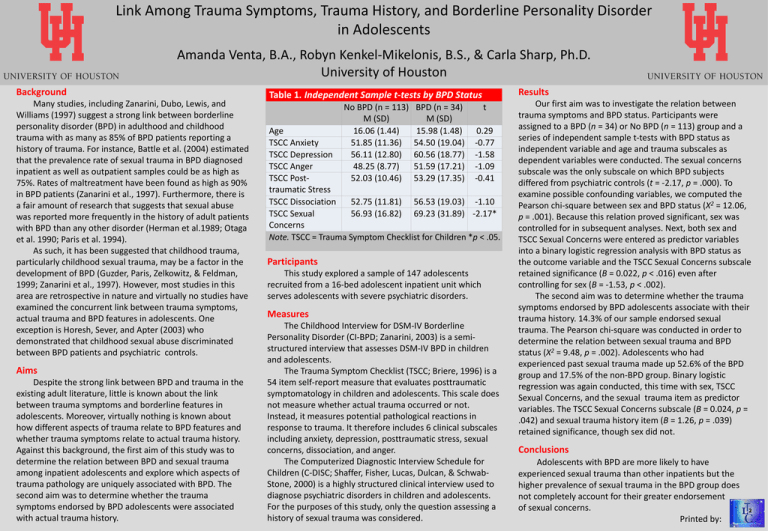
Link Among Trauma Symptoms, Trauma History, and Borderline Personality Disorder
in Adolescents
Amanda Venta, B.A., Robyn Kenkel-Mikelonis, B.S., & Carla Sharp, Ph.D.
University of Houston
Background
Many studies, including Zanarini, Dubo, Lewis, and
Williams (1997) suggest a strong link between borderline
personality disorder (BPD) in adulthood and childhood
trauma with as many as 85% of BPD patients reporting a
history of trauma. For instance, Battle et al. (2004) estimated
that the prevalence rate of sexual trauma in BPD diagnosed
inpatient as well as outpatient samples could be as high as
75%. Rates of maltreatment have been found as high as 90%
in BPD patients (Zanarini et al., 1997). Furthermore, there is
a fair amount of research that suggests that sexual abuse
was reported more frequently in the history of adult patients
with BPD than any other disorder (Herman et al.1989; Otaga
et al. 1990; Paris et al. 1994).
As such, it has been suggested that childhood trauma,
particularly childhood sexual trauma, may be a factor in the
development of BPD (Guzder, Paris, Zelkowitz, & Feldman,
1999; Zanarini et al., 1997). However, most studies in this
area are retrospective in nature and virtually no studies have
examined the concurrent link between trauma symptoms,
actual trauma and BPD features in adolescents. One
exception is Horesh, Sever, and Apter (2003) who
demonstrated that childhood sexual abuse discriminated
between BPD patients and psychiatric controls.
Aims
Despite the strong link between BPD and trauma in the
existing adult literature, little is known about the link
between trauma symptoms and borderline features in
adolescents. Moreover, virtually nothing is known about
how different aspects of trauma relate to BPD features and
whether trauma symptoms relate to actual trauma history.
Against this background, the first aim of this study was to
determine the relation between BPD and sexual trauma
among inpatient adolescents and explore which aspects of
trauma pathology are uniquely associated with BPD. The
second aim was to determine whether the trauma
symptoms endorsed by BPD adolescents were associated
with actual trauma history.
Results
Table 1. Independent Sample t-tests by BPD Status
No BPD (n = 113)
M (SD)
16.06 (1.44)
51.85 (11.36)
56.11 (12.80)
48.25 (8.77)
52.03 (10.46)
BPD (n = 34)
M (SD)
15.98 (1.48)
54.50 (19.04)
60.56 (18.77)
51.59 (17.21)
53.29 (17.35)
t
Age
0.29
TSCC Anxiety
-0.77
TSCC Depression
-1.58
TSCC Anger
-1.09
TSCC Post-0.41
traumatic Stress
TSCC Dissociation
52.75 (11.81) 56.53 (19.03) -1.10
TSCC Sexual
56.93 (16.82) 69.23 (31.89) -2.17*
Concerns
Note. TSCC = Trauma Symptom Checklist for Children *p < .05.
Participants
This study explored a sample of 147 adolescents
recruited from a 16-bed adolescent inpatient unit which
serves adolescents with severe psychiatric disorders.
Measures
The Childhood Interview for DSM-IV Borderline
Personality Disorder (CI-BPD; Zanarini, 2003) is a semistructured interview that assesses DSM-IV BPD in children
and adolescents.
The Trauma Symptom Checklist (TSCC; Briere, 1996) is a
54 item self-report measure that evaluates posttraumatic
symptomatology in children and adolescents. This scale does
not measure whether actual trauma occurred or not.
Instead, it measures potential pathological reactions in
response to trauma. It therefore includes 6 clinical subscales
including anxiety, depression, posttraumatic stress, sexual
concerns, dissociation, and anger.
The Computerized Diagnostic Interview Schedule for
Children (C-DISC; Shaffer, Fisher, Lucas, Dulcan, & SchwabStone, 2000) is a highly structured clinical interview used to
diagnose psychiatric disorders in children and adolescents.
For the purposes of this study, only the question assessing a
history of sexual trauma was considered.
Our first aim was to investigate the relation between
trauma symptoms and BPD status. Participants were
assigned to a BPD (n = 34) or No BPD (n = 113) group and a
series of independent sample t-tests with BPD status as
independent variable and age and trauma subscales as
dependent variables were conducted. The sexual concerns
subscale was the only subscale on which BPD subjects
differed from psychiatric controls (t = -2.17, p = .000). To
examine possible confounding variables, we computed the
2
Pearson chi-square between sex and BPD status (Χ = 12.06,
p = .001). Because this relation proved significant, sex was
controlled for in subsequent analyses. Next, both sex and
TSCC Sexual Concerns were entered as predictor variables
into a binary logistic regression analysis with BPD status as
the outcome variable and the TSCC Sexual Concerns subscale
retained significance (B = 0.022, p < .016) even after
controlling for sex (B = -1.53, p < .002).
The second aim was to determine whether the trauma
symptoms endorsed by BPD adolescents associate with their
trauma history. 14.3% of our sample endorsed sexual
trauma. The Pearson chi-square was conducted in order to
determine the relation between sexual trauma and BPD
status (Χ2 = 9.48, p = .002). Adolescents who had
experienced past sexual trauma made up 52.6% of the BPD
group and 17.5% of the non-BPD group. Binary logistic
regression was again conducted, this time with sex, TSCC
Sexual Concerns, and the sexual trauma item as predictor
variables. The TSCC Sexual Concerns subscale (B = 0.024, p =
.042) and sexual trauma history item (B = 1.26, p = .039)
retained significance, though sex did not.
Conclusions
Adolescents with BPD are more likely to have
experienced sexual trauma than other inpatients but the
higher prevalence of sexual trauma in the BPD group does
not completely account for their greater endorsement
of sexual concerns.
Printed by:




